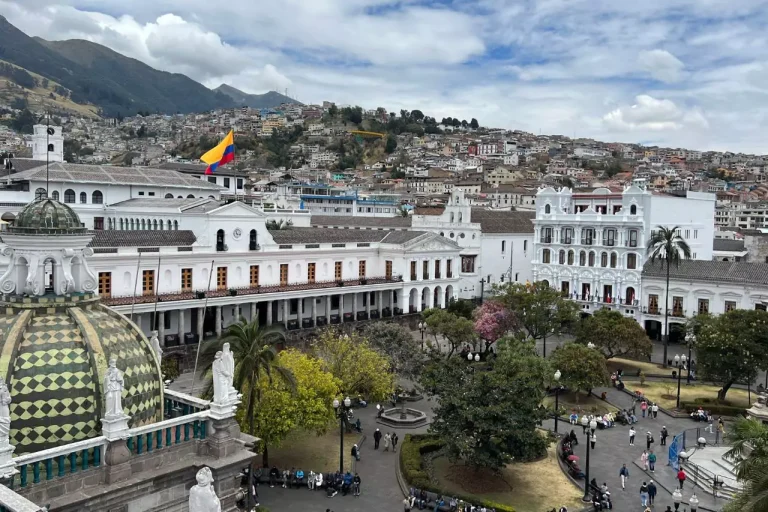Is Quito safe for tourists? If you’re planning a trip to Quito, Ecuador’s captivating capital nestled high in the Andes, you might be concerned about safety. In this blog, we’ll take a closer look at this important question, exploring various aspects of safety in Quito. We’ll draw on insights from different sources and perspectives to help you navigate your travels with confidence.
How Safe is Quito?
Quito can be considered relatively safe for tourists when appropriate precautions are taken. While the city faces challenges typical of many urban centers, it offers a rich cultural experience alongside its stunning architecture and beautiful landscapes.
In fact, Quito is generally considered one of the safer capitals in Latin America. To give you some context,
- Recent statistics show a 19% decrease in homicides in Quito as of August 2024 compared to the same period in 2023.
- The homicide rate in Quito was 9.7 per 100,000 inhabitants in 2023, which is lower than many other major Latin American cities.
- Petty crimes like pickpocketing and bag snatching are the most common issues tourists face, especially in crowded areas and on public transportation.
- The majority of tourists have safe and enjoyable experiences in Quito. Between January and July 2024, only 175 crimes against tourists were reported among over 357,000 visitors, marking a 40% decrease compared to the same period in 2023.
While this might sound high if you’re from a small town, it’s actually significantly lower than other major cities in the region like Caracas or Bogotá. So, relatively speaking, Quito is doing pretty well in terms of violent crime. If you’re traveling around Mexico, here’s a post on things to be careful of in Isla Mujeres.
Safe Areas in Quito and Potential Danger Zones

Understanding which areas are generally safe and which require extra caution is crucial for tourists visiting Quito.
Safe Areas
- González Suárez: This upscale neighborhood is considered one of the safest in Quito, offering luxury accommodations and fine dining.
- La Floresta: Known for its calm atmosphere and significant museums, La Floresta is fairly safe during the day.
- La Mariscal: This area is vibrant and lively, with many bars, restaurants, and an artisan market. It is generally safe during the day but requires caution at night.
- Quito Old Town: This area is convenient for tourists due to its proximity to many historic attractions. It is generally safe during the day with a police presence.
- La Carolina: This area is also considered safe for tourists and is recommended for its parks and recreational areas.
Potential Danger Zones
- El Ejido Park: This park is not tourist friendly at any time of the day, with reports of various unsafe activities occurring there.
- La Tola: Although not a typical tourist destination, this area is close to the Old Town and is considered unsafe.
- Panecillo ‘Mountain’: The area around the Virgin of the Panecillo statue is dangerous due to crime and aggressive stray dogs.
- Southern Quito: Areas such as Quitumbe, Guamani, and San Roque in the south of Quito are considered more dangerous and should be avoided by tourists.
Travel Advisories from Major Countries
Several countries have issued travel advisories for Ecuador, including specific guidance for Quito:
- United States: The U.S. Department of State has issued a Level 2 travel advisory, advising increased caution due to civil unrest, crime, and kidnapping.
- United Kingdom: The FCDO advises against all but essential travel to several coastal region provinces but does not specifically mention Quito as a high-risk area.
- Canada: The Canadian government advises exercising a high degree of caution in Ecuador due to high levels of crime.
- Australia: The Australian government advises exercising increased caution due to civil unrest, crime, and kidnapping.
Common Safety Concerns for Travelers
Now, let’s talk about the stuff you’re more likely to encounter as a traveler. The most common safety issues in Quito are:
- Petty Crime: Pickpocketing and bag snatching are the most frequent problems tourists face, especially in crowded areas and on public transportation.
- Scams: Watch out for common scams, including the infamous “mustard scam,” where someone points out a stain on your clothing as a distraction while an accomplice swipes your belongings.
- Transportation Safety: While public transportation is generally reliable, buses can be hotspots for minor thefts. Taxis are generally safe if they are licensed and identifiable by their orange license plates or white plates with an orange stripe.
- Altitude Sickness: Quito sits at a whopping 2,850 meters (9,350 feet) above sea level. This can cause headaches, nausea, and dizziness for some visitors.
- Water Safety: While tap water in Quito is technically potable, it’s advisable to drink bottled water due to potential contamination from old piping.
New Safety Initiatives and Measures
In response to safety concerns, several new initiatives have been implemented:
- Safe Communities Program: This U.S.-backed initiative has been implemented in 11 priority cities, including Quito, involving training for National Police officers and community crime prevention projects.
- Back to the Center Initiative: This program focuses on public space rehabilitation and urban planning in Quito’s Historic Center to enhance safety and promote tourism.
- Judicial System Strengthening: Efforts to improve the capacity to prosecute and sentence offenders have resulted in over 2,069 cases resolved in specialized courts since 2022.
- State of Emergency and Curfew: In response to increased gang violence, a nationwide state of emergency and curfew from 11 PM to 5 AM was implemented starting January 8, 2024.
Tourist Experiences and Safety in Quito
Despite the challenges, recent reports indicate positive experiences for tourists in Quito:
- Between January and July 2024, there were only 175 reported crimes against tourists among over 357,000 visitors, marking a 40% decrease in crimes like robbery, theft, and fraud compared to the same period in 2023.
- Tourists have expressed satisfaction with the safety and organization of Quito’s tourist attractions.
- The city continues to host major international events without issues, reinforcing its reputation as a safe destination for international conferences and business tourism.

Practical Safety Tips for Tourists
To ensure a safe and enjoyable visit to Quito, consider the following tips:
- Stay alert and be aware of your surroundings, especially in crowded areas.
- Use reliable transportation options like registered taxis or ride-sharing apps.
- Secure your belongings and avoid displaying valuables.
- Travel in groups when possible, especially at night.
- Avoid known danger zones, particularly after dark.
- Use ATMs inside banks or hotels.
- Learn basic Spanish to navigate the city more easily.
- Stay informed about local news and travel advisories.
Conclusion: Is Quito Safe for Tourists?
The answer is a cautious yes. Quito, like many major cities, has its challenges, but it offers a rich cultural experience that can be enjoyed safely with the right precautions. During my visit to Quito, I felt secure and did not encounter any safety issues, thanks in part to a knowledgeable tour guide who helped navigate the city.
While the recent decrease in homicides and initiatives to enhance tourist safety are encouraging signs, it is essential to remain vigilant due to certain types of crime and the presence of organized groups. Tourists should approach their visit with a balanced perspective, staying informed, and following local advice to minimize risks.
Quito’s historical significance, stunning architecture, and warm hospitality make it a worthwhile destination for those who are aware of their surroundings and respect local conditions.
Ultimately, safety is relative and can vary based on individual experiences. By taking necessary precautions and staying informed, most tourists can enjoy a safe and memorable experience in this captivating Andean capital.
Sources: Avenuemia, Human Rights Watch, Primicias, Travel State Gov, Gov UK, Travel GC CA.

Share this Image On Your Site
FAQ’s About Quito Safety
-
Is it safe to walk around Quito at night?
Walking around Quito at night can be risky. It’s advisable to stay in well-lit, populated areas and use trusted transportation options.
-
Is Quito worth visiting?
Yes, Quito is worth visiting for its stunning architecture, rich history, and beautiful landscapes.
-
Can you walk around Quito?
Yes, you can walk around Quito, especially in the historic center, but be mindful of your surroundings and stay alert.
-
Can tourists go to Ecuador?
Yes, tourists can visit Ecuador with a valid passport and no visa required for stays up to 90 days. Travelers should check health requirements and be aware of current safety advisories.
Explore More Travel Posts You’ll Love
Quito School of Art: Ecuador’s Unique Religious Art Legacy
Travel Guide to Valencia: Top Attractions and Advice
100 Must-Try Best Summer Bucket List Ideas for Adults (2025)
8 Unique Iceland Bucket List Destinations: Explore Off-the-Beaten-Path Locations


































